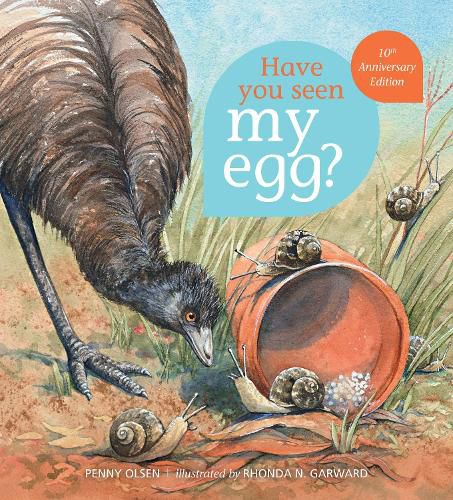Have you seen my egg? by Penny Olsen. Illus. by Rhonda N. Garward

This tenth anniversary edition is a most welcome book to present to young readers. Lifting the flap will intrigue and delight as the children read about an emu looking for his lost egg. Eddy asks many other animals, and we check out their offspring as he searches. He is puzzled. He asks the magpies, and they show him their eggs, small and spotty; the echidna’s egg is very different, while the lizard’s eggs are tiny compared to the emu eggs. Eddy goes on to talk to the frog with its small, black and white eggs, the spider with its eggs in a silk bag, the snail’s eggs are tiny and transparent, and the crocodile's eggs may be large like the emu eggs, but are white. Eddy goes on to talk to the shark, a turtle, penguins, a hen, and as children lift the flaps they see what these eggs reveal as they crack. Eddy goes back to his nest to find if any of his eggs have hatched and one has.
This is a lovely introduction to babies and offspring. Each of the animals is presented in its environment, informing the child not only about the animal and its eggs, but also where it lives. I found it wholly engrossing, and I loved the image on each page of Eddy searching for his lost egg.
The illustrations detail each animals and its eggs, encouraging the reader to be curious and questioning about the animal and its environment. The lizard for example, lives in an area more akin to a desert, with its rocks and wild flowers, whereas the turtle lives on a beach, sandy and soft, allowing it to dig a hole for its huge number of eggs. Readers will love pointing out the differences.
Each page provokes questions and promotes interest, and a need to discuss what they see and why the environment is important to that animal. And of course, this learning is all tailored with the quest of Eddy looking for his egg and children will give their attention to the reasons his eggs are different from those he comes across.
Four pages at the end of the book give more information about the animals shown in the book.
The book is a wonderful addition to books deemed as supporting STEM, giving amazing information about a group of animals, their reproduction and environments, and enthusing readers to carefully seek out eggs in their backyards.
Themes: Reproduction, Eggs, Australian animals, Environment.
Fran Knight